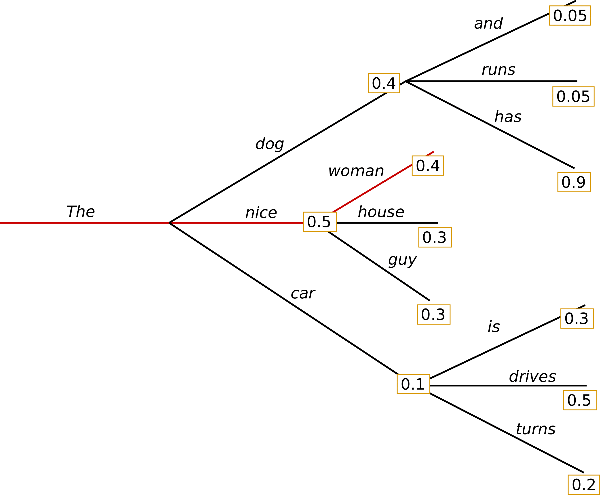Greedy Search
贪婪搜索指的是在每一个时间步中使用前n-1的词来预测第n个生成词。即
,在这个过程中,第n个词是前n-1个词预测的概率最高的词。

"""
Greedy Search
"""
import tensorflow as tf
from transformers import TFGPT2LMHeadModel, GPT2Tokenizer
tokenizer = GPT2Tokenizer.from_pretrained("gpt2")
# add the EOS token as PAD token to avoid warnings
model = TFGPT2LMHeadModel.from_pretrained("gpt2", pad_token_id=tokenizer.eos_token_id)
# 将句子转化为可用的输入形式
input_ids = tokenizer.encode('the japanese is so ', return_tensors='tf')
# 设置生成文本的最大长度未50
greedy_output = model.generate(input_ids, max_length=50, early_stopping=True)
"""
输出内容:
the japanese is so - that it's not even -
that it's -that it's - that it's - that it's - that it's
"""
Beam Search
虽然贪心搜索在每一步都能得到最优的解,但在总体上来看,可能会陷入到一个次优解或者是非常不好的解中。为此束搜索被提出来解决这个全局优化的问题,该算法在生成下一个单词的时候,会生成K个候选词,然后在这个基础上继续进行K个候选词的选择,最后在全局的基础上选择一条概率最大的路径。

# 这里使用了5个束来进行搜索
beam_output = model.generate(input_ids, max_length=50, early_stoppping=True, num_beams=5)
"""
the japanese is so iced up that I don't even know how to pronounce it.
I'm not sure how to pronounce it.
I'm not sure how to pronounce it.
"""由于以上的得到的结果会出现重复的输出内容,为此我们对其进行设置,使用n-gram penatly来确保没有n-gram在预测的句子中出现两次。但这样也会出现一个问题,那就是在需要重复的场景中,也只能出现一次。
ngram_beam_output = model.generate(input_ids, max_length=50, early_stoppping=True, num_beams=5,no_repeat_ngram_size=2) # 这里的no_repeat_gram_size表示ngram
"""
输出内容:
the japanese is so iced up that I don't even know how to pronounce it.
I'm not sure if it's because I'm lazy, or if I just want to be able to say it in Japanese, but I
"""
topk answer
对于生成的句子可能会存在表达或者语义的问题,有的时候我们需要查看多个生成的句子以人工搜索一个最好的句子。
ngram_beam_topk_output = model.generate(input_ids, max_length=50, early_stoppping=True, num_beams=5,no_repeat_ngram_size=2, num_return_sequences=5)
"""
0: the japanese is so iced up that I don't even know how to pronounce it.
I'm not sure if it's because I'm lazy, or if I just want to be able to say it in Japanese, but I
1: the japanese is so iced up that I don't even know how to pronounce it.
I'm not sure if it's because I'm lazy, or if I just want to be able to say it in Japanese, but it
2: the japanese is so iced up that I don't even know how to pronounce it.
I'm not sure if it's because I'm lazy, or if I just want to be able to read Japanese, but I think it
3: the japanese is so iced up that I don't even know how to pronounce it.
I'm not sure if it's because I'm lazy, or if I just want to be able to say it in Japanese. But I
4: the japanese is so iced up that I don't even know how to pronounce it.
I'm not sure if it's because I'm lazy, or if I just want to be able to read Japanese, but I think I
"""
sampling
采样是另外一种不同的策略,其对条件概率生成的词进行随机的采样。如下图所示,

tf.random.set_seed(0)
# print("Output:\n" + 100 * '-')
sample_output = model.generate(input_ids, do_sample=True, max_length=200, top_k=50)
print(tokenizer.decode(sample_output[0], skip_special_tokens=True))
"""
输出:
the japanese is so icky, that even the "Japan's food is the finest" is not really an excuse.
My point is what it is that does the Japanese taste better than others in this country. The reason is that
"""对于随机生成的句子,乍一看没问题,但是读起来很不合理,所以对于随机采样,我们尽可能地采样概率较高的词,而减少低概率词地采样
sample_output = model.generate(
input_ids,
do_sample=True,
max_length=50,
top_k=0,
temperature=0.9
)
print(tokenizer.decode(sample_output[0], skip_special_tokens=True))
"""
输出:
the japanese is so familiar with the Japanese language that it's hard to imagine it being used in a Japanese context.
The Japanese language is a very complex language, and it's hard to imagine a Japanese person using it in
"""为了进一步优化,我们只对前K个概率最高的词进行采样,
sample_output = model.generate(
input_ids,
do_sample=True,
max_length=50,
top_k=50
)
"""
the japanese is so iaa.
I mean, that's true that people are very hard at finding words in japanese. In fact it might
be more accurate to say that Japanese means "Japanese", which is what you
"""对于上面的方法,还可以对可能的词进行百分比的随机抽样,即采样最可能的词的概率(个人认为是对词的可能性/概率进行排序,然后只对前百分之多少的词进行采样)
# deactivate top_k sampling and sample only from 92% most likely words
sample_output = model.generate(
input_ids,
do_sample=True,
max_length=50,
top_p=0.92,
top_k=0
)
"""
the japanese is so!!!! Cuz of that, you forgot to put caps properly!!!!
I'll make this shit up for those who can't usually talk with one who can PLEASE READ THE INPICIOUS and SATURN INVINC
"""同样地,我们也可以对topk中的词进行概率为p的采样
# set top_k = 50 and set top_p = 0.95 and num_return_sequences = 3
sample_outputs = model.generate(
input_ids,
do_sample=True,
max_length=50,
top_k=50,
top_p=0.95,
num_return_sequences=3
)
"""
the japanese is so icky in mine. it's a lot like someone's salivating over peas and chocolate.
rxtfffffff.......ooh they need Japanese drinking?? Just a thought....... Join us and talk to us about all kinds
"""
版权声明:本文为qq_38901850原创文章,遵循 CC 4.0 BY-SA 版权协议,转载请附上原文出处链接和本声明。